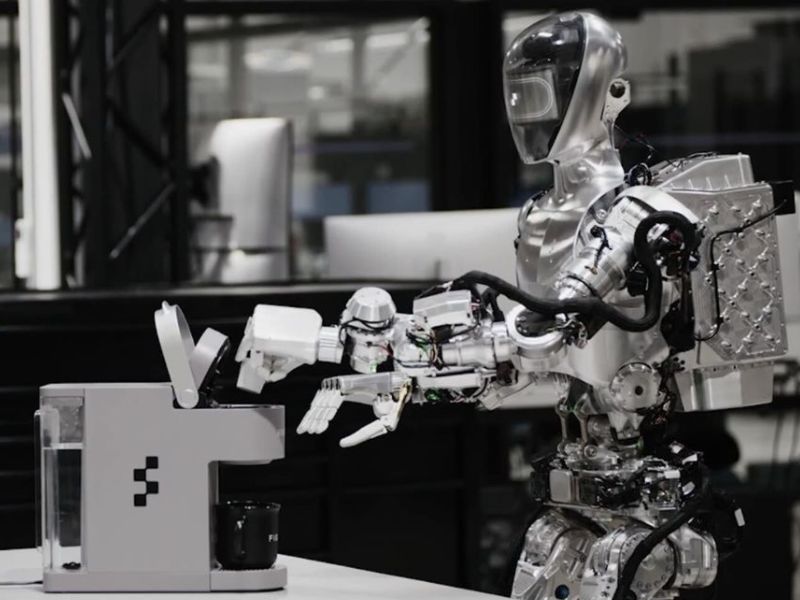
xr:d:DAF6GPF1IQI:2,j:9049273269829754738,t:24011700
Imagine waking up in the morning to the aroma of freshly brewed coffee and a perfectly folded stack of laundry—without lifting a finger. A humanoid robot capable of completing these household tasks could soon be more than a futuristic dream. In fact, this groundbreaking technology could be available as early as next year, revolutionizing the way we interact with home automation.
As robotics and artificial intelligence (AI) continue to advance at an unprecedented rate, companies are developing humanoid robots that can perform everyday chores, making life simpler for busy individuals. These robots are designed to integrate seamlessly into the home, handling tasks that would normally take up valuable time, such as laundry and coffee-making. For many, this could signal the dawn of a new era where robots become an indispensable part of daily life.
What Can These Humanoid Robots Do?
Humanoid robots are designed to mimic human appearance and movement, but they do more than just look human—they are being engineered to tackle some of the most mundane tasks that typically require a significant amount of effort. Some of the most exciting capabilities these robots will have include:
- Laundry Assistance:
One of the most sought-after features in household robotics is the ability to wash, dry, and fold laundry. By using advanced sensors and AI, these robots can identify fabric types, wash clothes with the appropriate settings, and even fold them neatly, saving you hours of manual labor every week. - Coffee Making:
If you’re someone who needs that perfect cup of coffee to start the day, these robots might be your new best friend. They can brew your favorite coffee—whether it’s espresso, cappuccino, or simple drip coffee—with precision, adapting to your specific preferences each time. - Task Automation and Assistance:
Beyond laundry and coffee, humanoid robots can be programmed to handle a variety of other tasks, such as preparing meals, cleaning the house, and even watering plants. With smart integration, they can follow commands or schedule tasks based on your routines, creating a fully automated home environment.
Why Are These Robots Becoming a Reality?
The push toward household humanoid robots is driven by advances in robotics, artificial intelligence, and machine learning. Companies like Tesla, Boston Dynamics, and others have made tremendous progress in creating robots that are not only highly functional but also more affordable and accessible to the general public. In the past, robots were seen as tools for industrial use or research, but now they are increasingly becoming consumer-friendly.
The demand for automation is also growing. As more people lead busy lives and juggle multiple responsibilities, time-saving innovations like humanoid robots are becoming more attractive. Whether it’s for elderly care, people with disabilities, or simply for convenience, these robots promise to relieve pressure and improve quality of life by handling repetitive and tiring household chores.
Challenges to Overcome: Cost and Complexity
While the concept of a humanoid robot doing laundry and making coffee is undeniably exciting, there are still several hurdles to overcome before these robots become commonplace.
- Cost:
Advanced humanoid robots capable of performing complex tasks like laundry and coffee-making are still a significant investment. Early models may cost tens of thousands of dollars, making them out of reach for the average consumer. However, as production scales and technology becomes more widespread, the price is expected to decrease, eventually making these robots more affordable for everyday households. - Complexity of Tasks:
Performing household chores like laundry requires a high level of dexterity and decision-making. A robot needs to differentiate between different types of clothing, use the right detergent, and know how to handle various fabric sensitivities. Similarly, brewing coffee requires a fine balance of temperature, timing, and user preferences. While current prototypes can handle these tasks with some success, robots will need to further refine their skills to meet the expectations of their users. - Social and Ethical Considerations:
The introduction of humanoid robots into homes also raises important ethical questions. Concerns about job displacement, privacy, and the impact on human relationships with machines are all part of the conversation. While robots can offer tremendous convenience, they also challenge traditional ideas about work, family dynamics, and social interaction.
The Future of Humanoid Robots in the Home
The potential for humanoid robots in the home extends far beyond laundry and coffee-making. In the future, these robots could act as personal assistants, caregivers, or even companions. With advancements in AI, they could learn about their users’ preferences over time, adapt to their routines, and become more integrated into daily life.
Experts predict that within the next decade, humanoid robots will become increasingly capable and affordable, with more households adopting them. For now, though, a more modest but exciting first step is on the horizon—robots capable of taking on chores like laundry and coffee-making, fundamentally changing the way we think about household management.



